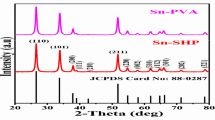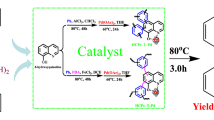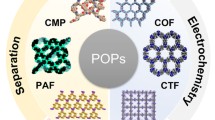Abstract
Novel film catalysts of the polystyrene (Ps) and trimethyl phosphate (P) nanoparticles were synthesized on glass substrates by soft chemistry using doctor blade method. Subsequently, the prepared Ps–P film catalysts were characterized by various techniques, including fourier transform infrared spectroscopy (FTIR), nuclear magnetic resonance (NMR), density (d), polarizing microscope (PM), X-ray diffraction (XRD) and thermal analysis. According to the results, the structure and morphology of film catalysts were confirmed by all analyses. The Ps–P films, as heterogeneous solid catalysts, have demonstrated strong activity for Knoevenagel condensation, producing alkenes of high purity. The recovered yields are excellent, up to 96% in solvent-free conditions at room temperature. Further, the film catalysts have showed high stability, good reusability (up to five times) while maintaining their efficiency and productivity.
Graphic Abstract
In the present study, the polystyrene/phosphate film catalysts were characterized and synthesized by soft chemistry method. These film catalysts were show an excellent catalytic activity for Knoevenagel condensation reaction. Further, they have demonstrated high yields, in solvent-free at room temperature, with a good reusability and high stability.














Similar content being viewed by others
References
Luo R, Li H, Du B, Zhou S and Zhu Y 2020 A simple strategy for high stretchable, flexible and conductive polymer films based on PEDOT: PSS-PDMS blends Org. Electron. 76 105451
Karim A and Kumar S 2000 In Polymer surfaces, interfaces and thin films (World Scientific Publishing Company) p. 304
Yin X, Zhang Z, Wu M, Zhang J and Xu G 2018 Toward transparent composite films with selective solar spectral, flame retardant and thermal insulation functions Mater. Chem. Phys. 216 365
Mohammed M I, El-sadek M S A and Yahia I S 2020 Optical linearity and bandgap analysis of RhB-doped PMMA/FTO polymeric composites films: a new designed optical system for laser power attenuation Opt. Laser Technol. 121 105823
Bathula C, Khadtare S, Buruga K, Kadam A, Shrestha N K and Noh Y 2018 Selenophene based benzodithiophene polymers as potential candidates for optoelectronic applications Dye. Pigment. 149 639
Rafique S, Abdullah S M, Badiei N, McGettrick J, Lai K T, Roslan N A, Lee H K H, Tsoi W C and Li L 2019 An insight into the air stability of the benchmark polymer: Fullerene photovoltaic films and devices: A comparative study Org. Electron. 76 105456
Wang Z, Guo S, Zhang B and Zhu L 2019 Hydrophilic polymers of intrinsic microporosity as water transport nanochannels of highly permeable thin-film nanocomposite membranes used for antibiotic desalination J. Memb. Sci. 592 117375
Ismayil K M M, Manaf O, Sujith A and Antony R 2019 Polymer thin films for chromatographic separation of plant pigments Mater. Lett. 252 321
Ali F M, Ashraf I M and Alqahtani S M 2017 Promising Cu-doped polyvinyl alcohol films for optical and photoconductive applications Phys. B Condens. Matter 527 24
Pangpaiboon N, Traiphol N, Promarak V and Traiphol R 2013 Retardation the dewetting dynamics of ultrathin polystyrene films using highly branched aromatic molecules as additives Thin Solid Films 548 323
Oluwaleye O, Madhuku M, Mwakikunga B and Moloi S J 2019 Studies of lattice structure, electrical properties, thermal and chemical stability of cobalt ion implanted Indium Tin Oxide (ITO) thin films on polymer substrates Nucl. Instruments Methods Phys. Res. Sect. B Beam Interact. Mater. Atoms 450 267
Xue L and Han Y 2011 Pattern formation by dewetting of polymer thin film. Prog. Polym. Sci. 36 269
Li Z, Zhong W, Ying L, Liu F, Li N, Huang F and Cao Y 2019 Morphology optimization via molecular weight tuning of donor polymer enables all-polymer solar cells with simultaneously improved performance and stability Nano Energy 64 103931
Arinda P S, Santjojo D J D H, Masruroh M and Sakti S P 2019 Stability of polystyrene film surface wettability modified using oxygen plasma Mater. Today Proc. 13 24
Mouhamad Y, Mokarian-Tabari P, Jones R A L and Geoghegan M 2019 Application of mean-field theory to the spin casting of polystyrene and poly (methyl methacrylate) blend films from toluene Polymer 178 121578
Das S and Mahalingam H 2019 Dye degradation studies using immobilized pristine and waste polystyrene-TiO2/rGO/g-C3N4 nanocomposite photocatalytic film in a novel airlift reactor under solar light J. Environ. Chem. Eng. 7 103289
Jalal N M, Jabur A R, Hamza M S and Allami S 2019 Preparation, microstructure and morphology of electrospun sulfonated polystyrene films for proton exchange membrane hydrogen fuel cell Energy Proc. 157 1494
Sabet M, Soleimani H, Mohammadian E and Hosseini S 2019 Impact of inclusion graphene oxide nanosheets on polystyrene properties Int. J. Plas. Technol.1–9
Bhavsar S, Patel G B and Singh N L 2018 Investigation of optical properties of aluminium oxide doped polystyrene polymer nanocomposite films Phys. B Condens. Matter 533 12
James J, Unni A B, Taleb K, Chapel J P, Kalarikkal N, Varghese S, Vignaud G and Grohens Y 2019 Surface engineering of polystyrene–cerium oxide nanocomposite thin films for refractive index enhancement Nano-Struct. Nano-Obj. 17 34
Chouryal Y N, Sharma R K, Acharjee D Gnguly T, Pandey A and Ghosh P 2019 Influence of ionic liquids and concentration of red phosphorous on luminescent Cu3P nanocrystals J. Chem. Sci. 131 93
El Aadad H, Rair D and Chahine A 2019 Synthesis and characterization of novel organic–inorganic hybrid nanocomposites of phosphate–benzimidazole by soft chemistry route in aqueous media SN Appl. Sci. 1 1474
Mncwabe Z, Farahani M D and Friedrich H B 2019 Switching between oxidation types using molybdenum phosphate catalysts for paraffin activation using doped fe as surface acidity modifier and MoO x as an oxygen insertion tool Catal. Lett. 1
Omer K M, Mohammad N N and Baban S O 2018 Up-conversion fluorescence of phosphorous and nitrogen co-doped carbon quantum dots (CDs) coupled with weak LED light source for full-spectrum driven photocatalytic degradation via ZnO-CDs nanocomposites Catal. Lett. 148 2746
Jadhav A L and Yadav G D 2019 Clean synthesis of benzylidenemalononitrile by Knoevenagel condensation of benzaldehyde and malononitrile: effect of combustion fuel on activity and selectivity of Ti-hydrotalcite and Zn-hydrotalcite catalysts J. Chem. Sci. 131 79
Prajapati D, Lekhok K C, Sandhu J S and Ghosh A C 1996 Lithium bromide as a new catalyst for carbon–carbon bond formation in the solid state J. Chem. Soc. Perkin Trans. 9 959
Brufola G, Fringuelli F, Piermatti O and Ferdinando P 1997 Efficient one-pot synthesis of 7-azacoumarins by Knoevenagel reaction using water as reaction medium Heterocycles. 45 1715
Berni A, Mennig M and Schmidt H 2004 Doctor blade In Sol-gel technologies for glass producers and users p.89
Degallaix S and Ilschner B 2007 In Caractérisation expérimentale des matériaux I (TM volume 2) Propriétés physiques, thermiques et mécaniques in (ed. Presses Polytechniques Et Universitaires Romandes) p.420
Biémont É 2008 In Spectroscopie moléculaire, Structures moléculaires et analyse spectrale in (ed. De Boeck supérieur) p.320
Branan N and Wells T A 2007 Microorganism characterization using ATR–FTIR on an ultrathin polystyrene layer Vib. Spectrosc. 44 192
Rair D, El aadad H, Jermoumi T and Chahine A 2018 Spectroscopic and thermal degradation studies of novel hybrid polymer based on sodium polyphosphate - polystyrene Med. J. Chem. 7 337
Tekin N and Cebe M 2004 Solvents effect on infrared spectra of trimethyl phosphate in organic solvents Vib. Spectrosc. 36 129
Reva I, Simao A and Fausto R 2005 Conformational properties of trimethyl phosphate monomer Chem. Phys. Lett. 406 126
Mäkie P, Westin G, Persson P and Österlund L 2011 Adsorption of trimethyl phosphate on maghemite hematite, and goethite nanoparticles J. Phys. Chem. A 115 8948
Mastrantonio G and Della Védova C O 2001 Spectroscopic and conformational comparative study of trimethyl chalcogenphosphates J. Mol. Struct. 561 161
Bevington J C and Huckerby T N 2006 Studies of end-groups in polystyrene using 1H NMR Eur. Polym. J. 42 1433
Streck R and Barnes A J 1999 Solvent effects on infrared, 13C and 31P NMR spectra of trimethyl phosphate: Part 1. Single solvent systems Spectrochim. Acta Part A Mol. Biomol. Spectrosc. 55 1049
Meng Q, Doetschman D C, Rizos A K, Lee M H, Schulte J T, Spyros A and Kanyi C W 2011 Adsorption of organophosphates into microporous and mesoporous NaX zeolites and subsequent chemistry Environ. Sci. Technol. 45 3000
OCDE 2012 Ligne directrice de l’OCDE pour les essais de produits chimiques. Daphnia magna, essai de reproduction OECD Environ. Heal. Saf. Publ. p.28
Belitskus D 1993 In Fiber and whisker reinforced ceramics for structural applications. in (ed. CRC Press) p.11
Alekseeva O V, Bagrovskaya N A and Noskov A V 2018 Effect of C60 filling on structure and properties of composite films based on polystyrene Arab. J. Chem. 11 1160
Botan R, Nogueira T R, Lona L M F and Wypych F 2011 Synthesis and characterization of exfoliated polystyrene-layered double hydroxide nanocomposites via in situ polymerization. Polímeros-Ciência e Tecnol. 21 34
Bhadra J, Al-Thani N J, Madi N K and Al-Maadeed M A 2013 Preparation and characterization of chemically synthesized polyaniline–polystyrene blends as a carbon dioxide gas sensor Synth. Met. 181 27
N’Dri K, Houphouet-Boigny D and Jumas J C 2012 Study of first sharp diffraction peak in As2S3 glasses by X-ray powder diffraction method J. Non-Oxide Glas. 3 29
Ahmetli G, Cerit A and Kocaman S 2013 Synthesis and characterization of UV-crosslinkable unsaturated ketone group containing polystyrene films Prog. Org. Coat. 76 884
Faravelli T, Bozzano G, Colombo M, Ranzi E and Dente M 2003 Kinetic modeling of the thermal degradation of polyethylene and polystyrene mixtures J. Anal. Appl. Pyrolysis 70 761
El Watik L, Antonetti P, Claire Y, Zineddine H, Kaloustian J, Rossi C and Perichaud A. 1998 Etude de la dégradation thermique du polystyrène choc ignifugé J. Therm. Anal. Calorim. 53 297
Benzekri Z, El Mejdoubi K, Boukhris S, Sallek B, Lakhrissi B and Souizi A 2016 Dicalcium phosphate dehydrate DCPD as a highly efficient and reusable catalyst for Knoevenagel condensation Synth. Commun. 46 442
Dhakshinamoorthy A, Heidenreich N, Lenzen D and Stock N 2017 Knoevenagel condensation reaction catalysed by Al-MOFs with CAU-1 and CAU-10-type structures Cryst. Eng. Comm. 19 4187
Zhai Z W, Yang S H, Lv Y R, Du C X, Li L K and Zang S Q 2019 Amino functionalized Zn/Cd-metal–organic frameworks for selective CO2 adsorption and Knoevenagel condensation reactions Dalt. Trans. 48 4007
Rong N, Qiu T, Qian R, Lü L, Huang X, Ma Z and Cui C 2017 Three pyrazole-3-carboxylic acid complexes as efficient solvent-free heterogeneous catalysts for CC bond formation Inorg. Chem. Commun. 86 98
Madasamy K, Kumaraguru S, Sankar V, Mannathan S and Kathiresan M A 2019 Zn based metal organic framework as a heterogeneous catalyst for C–C bond formation reactions New J. Chem. 43 3793
Sakthivel B and Dhakshinamoorthy A 2017 Chitosan as a reusable solid base catalyst for Knoevenagel condensation reaction J. Colloid Interface Sci. 485 75
Jiang W, Yang J, Liu Y-Y, Song S-Y and Ma J-F 2017 A stable porphyrin-based porous mog metal–organic framework as an efficient solvent-free catalyst for C–C bond formation Inorg. Chem. 56 3036
Rosati O, Lanari D, Scavo R, Persia D, Marmottini F, Nocchetti M, Curini M and Piermatti O 2018 Zirconium potassium phosphate methyl and/or phenyl phosphonates as heterogeneous catalysts for Knoevenagel condensation under solvent free conditions Microporous Mesoporous Mater. 268 251
Khoshnavazi R, Bahrami L and Rezaei M 2017 Heteropolytungstostannate as a homo-and heterogeneous catalyst for Knoevenagel condensations, selective oxidation of sulfides and oxidative amination of aldehydes RSC Adv. 7 45495
Jlassi R, Ribeiro A P, Tiago G A, Wang J, Krawczyk M S, Martins L M D R S, Naili H, Pombeiro A J L and Rekik W 2018 Elementary and efficient catalyst process for the Knoevenagel condensation of araldehydes with arylmethylidene malononitrile Inorg. Chim. Acta 471 76
Arghan M, Koukabi N and Kolvari E 2019 Polyvinyl amine as a modified and grafted shell for Fe3O4 nanoparticles: As a strong solid base catalyst for the synthesis of various dihydropyrano [2, 3-c] pyrazole derivatives and the Knoevenagel condensation J. Saudi Chem. Soc. 23 150
Ouaddari H, Beqqour D, Bennazha J, El Amrani I E, Albizane A, Solhy A and Varma R S 2018 Natural Moroccan clays: Comparative study of their application as recyclable catalysts in Knoevenagel condensation Sustain. Chem. Pharm. 10 1
Acknowledgements
We thank Dr Mrabet Souad for their assistance in the polarizing microscope analysis.
Author information
Authors and Affiliations
Corresponding authors
Electronic supplementary material
Below is the link to the electronic supplementary material.
Rights and permissions
About this article
Cite this article
EL AADAD, H., BENZEKRI, Z., BOUKHRIS, S. et al. Synthesis, characterization of polystyrene-phosphate films and their application as heterogeneous catalyst for Knoevenagel condensation in solvent-free conditions. J Chem Sci 132, 87 (2020). https://doi.org/10.1007/s12039-020-01798-x
Received:
Revised:
Accepted:
Published:
DOI: https://doi.org/10.1007/s12039-020-01798-x




